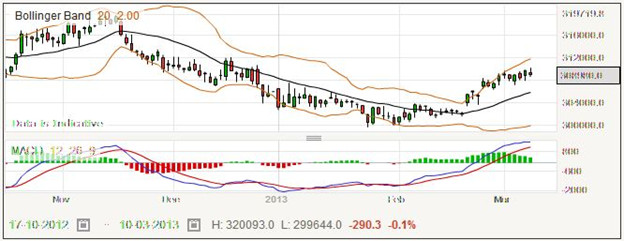Trading the USD/RUB Currency Pair
The USD/RUB is the exchange rate between the US dollar and the Russian rouble, currently running around 30 roubles to the dollar. You see that the chart is very volatile, which makes it attractive for spread betting, although you have to keep an eye on the news for any signs of manipulation.
In fact, one of the strongest influences on the Russian rouble is the price of oil, as Russia is a major producer of oil as well as natural gas. The price of oil is crucial to the Russian economy, so you should be looking at the oil futures markets when deciding which way this currency pair may go.
Russia is interesting as a petro-currency, but it is also has the influence of being one of the emerging markets, the so-called BRIC economies. The term was first coined about 10 years ago, when it was predicted that the four economies that make up the BRIC (Brazil, Russia, India, and China) would be wealthier than the current major powers in a few decades time. China and India would become major manufacturers, while Brazil and Russia would be major suppliers of raw materials to the world’s economies.
The Russia/Ukraine conflict has also received a lot of media coverage via financial news sites and tv channels which has helped traders appreciate the ramifications of President Putin’s stalemate with the West and how geopolitical developments can lead to profitable trading opportunities. In particular, the rouble has been under severe pressure against the euro and dollar pairs and the Russian Central bank may decide to keep raising interest rates to combat inflation and curb the flights of assets and attract new investment.
The chart above shows that the 30 roubles to the US dollar level is providing strong support, and the price has risen from there in the last few months. The current uptrend is clearly marked in the MACD levels below, as was the downtrend towards the end of 2012. Technical analysis tools will work well as long as there are no major government interventions. In general, the US is weakening the dollar by progressive quantitative easing and exceptionally low interest rates which have been promised to last for several more years. That means that other currencies, if not adopting the same stance, should gradually become more valuable against the US dollar.
USD/RUB Rolling Daily Spread Bet
The US dollar versus the Russian rouble currency pair is currently in an uptrend, and the spread betting price is quoted at 308,850 – 309,250 for a daily rolling bet. Because of the way that Forex works, using pips, in practice this means that there are just over 30 roubles to the dollar. If you think that the upward trend will continue, you could place a long bet, buying at 309,250 with a stake of £.20 per point.
Say your bet is good, and the price goes up to 312,450 – 312,850. You decide to collect your profit and close your trade. Your long bet was placed at the buying price of 309,250. It closes at the selling price of 312,450. The difference between these is 3200 points. You staked £.20 per point, so this works out to a win of £640.
But suppose the price falls after you place your bet. You might decide to cut your losses and end your spread bet when the quote is 307,050 – 307,450. Your bet would close at the 307,050 price. Taking a 307,050 away from 309,250, the result is 2200, the number of points you lost. Multiplying by your stake of £.20 per point your losses work out to £440.
Many spread traders use the stoploss order to protect them from losses becoming too large, even if they are not watching the markets. The spread betting provider must close a losing trade for you if it reaches a losing level that you set. With a stoploss order, this losing trade might have been closed when the quote was 307,770 – 308,170. When you set the stoploss order, you should note that the price is not normally guaranteed, although you can pay extra for this feature through a larger spread. In this case, with an opening price of 309,250 and a closing price of 307,770, you would have lost 1480 points which would cost you £296.



Join the discussion